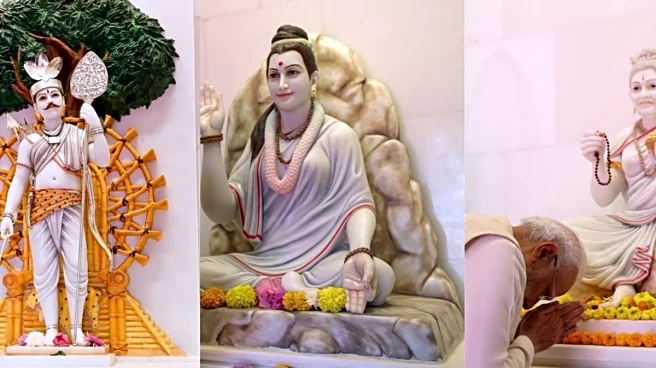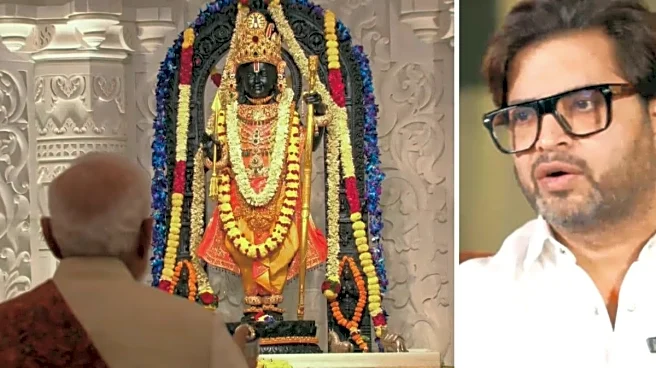Prime Minister Narendra Modi on Tuesday offered prayers at the Sapt Mandir located within the Shri Ram Janmabhoomi Temple complex in Ayodhya. PM Modi prayed at the Sapt Mandir on Tuesday as he ceremonially hoisted the saffron Dharma Dhwaj atop the Ram Temple’s towering shikhar in Ayodhya, marking what he described as the “fulfilment of a 500-year civilisational resolve.”
“These seven sacred shrines, dedicated to Maharishi Vashishtha, Maharishi Vishwamitra, Maharishi Agastya, Maharishi Valmiki, Devi Ahalya, Nishadraj and Mata Shabari offer us both wisdom and devotion. It is this divine grace that helps us become worthy of following the ideals of Prabhu Shri Ram,” PM Modi wrote on X after offering prayers at the Sapt Mandir.
What is Sapt Mandir?
The Sapt Mandir in Ayodhya
is a cluster of seven small yet spiritually significant shrines located within the larger Shri Ram Janmabhoomi Temple complex. Conceived as a tribute to the seven distinguished figures who shaped the life, journey, and legacy of Lord Ram, the Sapt Mandir offers devotees a deeper and more holistic connection to the Ramayana. Each of the seven shrines honours a personality whose presence or influence was pivotal in Ram’s story — sages, devotees, and companions whose virtues reflect key teachings of the epic.
The concept behind the Sapt Mandir is rooted in the idea that Ram’s divinity was supported and enriched by the people around him. Thus, honouring these figures is a way of honouring the values they represent: wisdom, courage, loyalty, devotion, forgiveness, and the transformative power of righteousness. The seven personalities enshrined here are Maharishi Vashistha, Maharishi Vishwamitra, Maharishi Agastya, Maharishi Valmiki, Devi Ahalya, Nishadraj Guha, and Mata Shabari. Each temple contains an idol or representation of one figure, allowing devotees to reflect on their unique contribution to the Ramayana’s narrative.
The Sapt Mandir reflects the broader Nagara style of the Ram Temple, maintaining harmony with the complex while offering a quieter, more contemplative precinct. The shrines are arranged in a way that encourages pilgrims to walk through them sequentially, symbolising a journey through the moral and spiritual milestones that accompany Ram’s story.
Who Do The Seven Shrines Honour?
The “Sapt” (meaning seven) in the temple refers to seven revered sages, devotees, and companions of Lord Ram.
The seven are:
1. Maharishi Vashistha
Lord Ram’s kul-guru (royal preceptor) and one of the most revered sages in Hindu tradition. He guided the Ikshvaku dynasty and performed Lord Ram’s childhood rituals. His wisdom shaped Ram’s early life and values.
2. Maharishi Vishwamitra
The sage who trained young Lord Ram and Lakshman in warfare and divine astras. He took them on their first mission to protect his yajna, and later guided Lord Ram to Sita by leading him to Mithila. He transformed from king to Brahmarishi through immense tapas.
3. Maharishi Agastya
A revered sage known for balancing the earth by settling in the South. He provided divine weapons and counsel to Lord Ram before the Lanka war. Agastya’s ashram is a key stop in Ram’s exile journey.
4. Maharishi Valmiki
The author of the Ramayana and protector of Sita during her exile. He gave refuge to Sita and raised Luv and Kush, who later narrated the epic before Lord Ram himself.
5. Devi Ahalya
A virtuous woman who was turned into stone due to a curse. Lord Ram liberated her with the touch of his feet during his forest exile, symbolising compassion and redemption. Her story reflects purity and divine grace.
6. Nishadraj Guha
The king of the Nishads and Lord Ram’s close friend. He supported Rama during his exile, famously helping them cross the Ganga. His loyalty is celebrated as one of the purest examples of friendship in the epic.
7. Mata Shabari
An elderly devotee who waited her entire life for Lord Ram’s arrival. She offered him ber fruits after tasting them for sweetness — an act remembered as the pinnacle of bhakti (devotion). Ram blessed her with liberation.
Spiritually, the Sapt Mandir expands the idea of devotion beyond Lord Ram, reminding pilgrims that the Ramayana is a tapestry of relationships, sacrifices, and teachings.




/images/ppid_59c68470-image-176404254318967233.webp)

/images/ppid_a911dc6a-image-176421964237037643.webp)

/images/ppid_a911dc6a-image-176407663416130068.webp)




/images/ppid_a911dc6a-image-176399090137472185.webp)
/images/ppid_a911dc6a-image-176404023431165343.webp)
